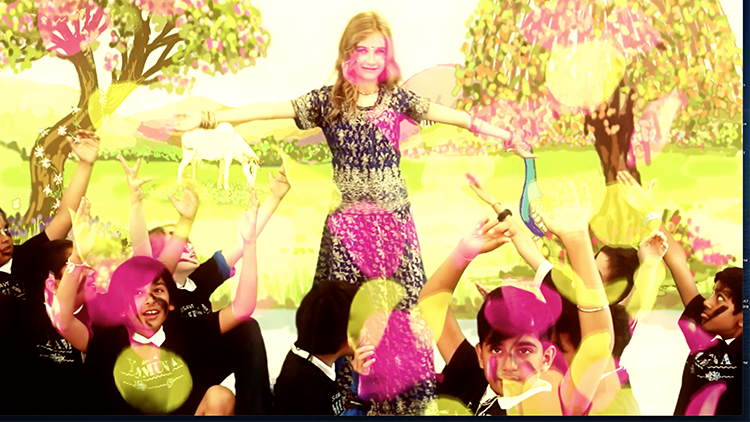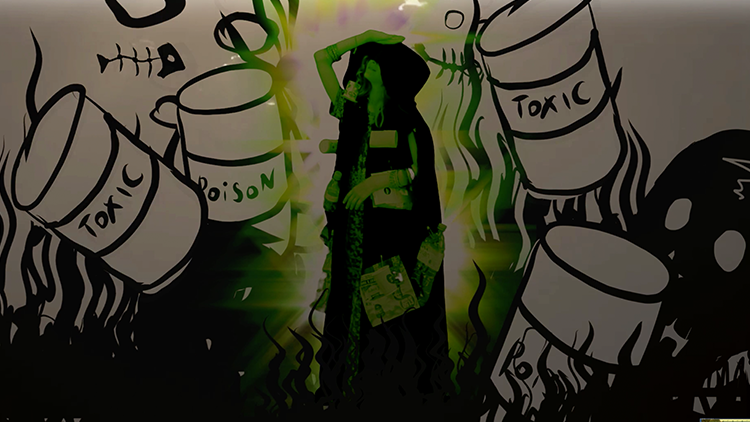Give Us Back The Yamuna River – New Video by Jayadeva Das and the Bhaktivedanta Manor Children
By Patita Pavana Dasa | May 06, 2020

(Lord Brahma said) “Then also when the cowherd boys and their animals drank the poisoned water of the River Yamunā, and after the Lord (in His childhood) revived them by His merciful glance, just to purify the water of the River Yamunā He jumped into it as if playing and chastised the venomous Kāliya snake, which was lurking there, its tongue emitting waves of poison. Who can perform such herculean tasks but the Supreme Lord?” (Shrimad-Bhagavatam 2.7.28)
India’s sacred Yamuna River, whose sanctity is considered by devotees to surpass even that of the Ganges, has today become a dead stream of poisonous chemical waste, plastic bags and sewage. What a crime and ecological disaster for a river that is not only glorified throughout the Puranas and Mahabharata, but which throughout history has been described as Diamouna by Ptolemy, Jomanes by Pliny, and Jobares by Arrian, The Yamuna rises from Himalayan glaciers near Bandarpunch where Hanuman extinguished his burning tail after torching Shri Lanka. No place is more sacred along its banks than in Vrindavana where Lord Shri Krishna, the Son of Nanda and Supreme Personality of Godhead, enjoyed the association of His devotees—whether gopis or gopas. Along the Yamuna’s 860 mile course to meet the Ganga many other rivers join her including the Banganga, Chambal and Betwa.
Today looking back I remember my first visit to the Yamuna in 1973. As I emerged out of Vrindavana’s woodlands by way of the sandy parakrama trail, my first glance of this gentle stream as she curved through Vrindavana took me aback. Bearded saints whose physical ages defied estimation sat meditatively on the shore, or stood waist-deep in the fresh waters absorbed in prayerful mantras. The serene atmosphere was surcharged with a strong sense of sanctity that I can feel to this day.

Jayadev and the students
There was an old lady by the shore selling splashes of mustard oil. I asked her for a little of it and she held out her hand expectantly. The only coin I had was a British shilling hidden away in my pocket which I handed over. Squinting and carefully examining it front and back, she put it in her purse and—to my surprise—she gave me an aluminum five paisa coin in return along with a palm full of the sarso oil. And, just as Shrila Prabhupada had promised in his talks and books, the morning bath in the Yamuna was like swimming in nectar. I remember submerging myself so that her flow came up to just below my eyes. From that vantage point the swirling waters turned a charming transcendental blackish color; so appropriate for a dark river goddess named Kalindi. The goddess Yamuna rides the tortoise—kachwa in Hindi—and as proof of this we would see families of these kachwas surfacing at the ghats where the pilgrims fed them.
I joined a tour with our legendary Godbrother Gurudasa Prabhu, one of the first disciples of Shrila Prabhupada, and one of the first ISKCON devotees to serve the Hare Krishna Movement in Vrindavana, also. Naturally, his tour included talks about the holiness of the Yamuna—which was certainly fitting since his equally legendary better half had been initiated with the name of Yamuna dasi by Shrila Prabhupada. At the Shri Madana Mohana Temple Gurudasa invited the small group of us to drink from the well of Sanatana Goswami where Lord Krishna had personally served water to the great Vaishnava acharya with His own hand. This well sits on a bank overlooking the Yamuna, a section where once the river once widened into a huge lake called Kaliya Dah. This is the very spot where 5,000 years earlier Lord Krishna had jumped in to save the Vrajavasis from the poisonous effects of the multi-headed snake demon Kaliya.

Kaliya’s modern-day influence – a screenshot from Jayadeva’s video
Gurudasa’s talk alongside the Yamuna inspired me and the sip of water from the well of Sanatana Goswami became an epiphany that struck me like a bolt of lightning. I was inspired then and there that someday I would write a book on tirtha yatra Vrindavana for the sake of the devotees. Shrila Prabhupada approved the project and it would be published some seven or eight years later by his grace. My Touring the Land of Krishna became the first comprehensive guidebook to Vraja Bhumi in the English language.
Ensuing research for the book would take me up and down the Yamuna. Once in a flood while the Yamuna was in spate and flowing above tree tops I hopped in along with my Godbrother Vaikunthanath. Laughing we let the current carry us the ten kilometers downstream to Mathura. Locals yelled at us from the banks—and later we discovered that they were warning us against angry cobras that were being carried along with by the waves. Somehow Krishna protected us from those relatives of Kaliya, and we climbed ashore at Mathura from where we took a rickshaw back to the Raman Reti ashram.
Still curious to explore the length of river, I “discovered” Nigambodh Ghat in Delhi where King Yudhisthira performed the great Rajasuya Yagna. I ventured into the Himalayas and stayed with sadhus near her source at Yamunottari, where sulfuric hot springs testify to her birth as the daughter of the Sun god. Her birth is describes in Shrimad-Bhagavatam (6.6.40) wherein it is stated that Samjna, the wife of the Sun demigod Vivaswan gave birth to the twins Yamaraja and Yamuna. I followed her downstream to Prayagraja where her blackish waters merge with the whitish Ganga at Triveni Sangam. There I swam out to see the line where white meets black. Suddenly I found my becoming swept away by the current until a friendly boatman came to my rescue.

Passionate ‘Save Yamuna’ activists students in the video
But now those days of nearly half a century back are mere memories; they have vanished from the landscape like the Yamuna herself. And I wonder, like millions of other devotees, whether the glory days of the Yamuna can ever return. For today through industrial waste, neglect, mismanagement, and the heedlessness of the public, the Yamuna has become so badly contaminated that basically the river no longer exists. Polluted beyond belief, the Yamuna has now been declared … dead.
Enter Jayadeva dasa, drummer for the legendary glam band Rubettes and staunch devotee of Lord Shri Krishna, the Supreme Personality of Godhead. Jayadeva, aka John Richardson, knows a bit about grabbing the attention of the public, and today he is on a mission to save the Yamuna.
The Rubettes’ first single “Sugar Baby Love” topped out at number one on the UK Singles Chart and stayed there for four weeks during May of 1974. Several hits followed with huge popularity for the group in France and throughout the European mainland. Throughout the first decade and a half of this 21st century, Jayadeva was just as much at home on stage reliving Rubette glory days with his fellow bandmates as he was with an accordion out on the streets of London or Moscow chanting with the sankirtana party.
But today Krishna has given the task of conquering the new face of the Kaliya demon—industrial waste—over to His devotees; and 72-year old Jayadeva has joined the activism. Now he leads the chant “Give Us Back the Yamuna!”
Can a video save a dead river? It may sound far-fetched, but miracles happen through public awareness—especially when Krishna Himself notices the sincere devotion of his bhaktas. It wasn’t so long ago that a 12-year old devotee names Shri Prahlada in Australia recorded a song about imprisoned Russian devotees. His plea somehow caught the attention of the world and created a snowball effect that eventually freed many Soviet devotees who had been locked up behind bars for the “crimes” of reading Bhagavad-gita and chanting Hare Krishna.
As it is often said, “The journey of a thousand miles begins with the first step.” And the first step to becoming active in the plight of the Yamuna is to make ourselves aware of the serious situation of Lord Krishna’s favorite river.
* * *
To listen to Jayadeva’s music and support the Save Yamuna campaign, please click here: https://ditto.fm/the-stolen-river?fbclid=IwAR0qcC1hdXX2V3-jHV-zi9aPb4EWqKm82cwCTE1fwt7O_T7DV3I6FqbN7ok
If you want to learn more about this subject please watch the multi-award-winning The Stolen River documentary produced and directed by ISKCON devotees: https://vimeo.com/ondemand/thestolenriver3















